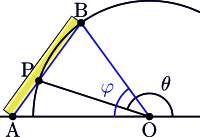Neusis construction facts for kids
The neusis is a geometric construction method that was used by ancient Greek mathematicians. At that time, people did not have good rules to measure distances. They did not know algebra. So, they studied geometry by moving fixed length sticks around on a piece of paper.
Geometric construction
The neusis construction (from Greek νεῦσις from νεύειν neuein "incline towards"; plural: νεύσεις neuseis) fits a line element of given length (a) in between two given lines (l and m), in such a way that the line element, or its extension, passes through a given point P. That is, one end of the line element has to lie on l, the other end on m, while the line element is "inclined" towards P.
A neusis construction might be performed by means of a 'Neusis Ruler': a marked ruler that is rotatable around the point P (this may be done by putting a pin into the point P and then pressing the ruler against the pin). In the figure, one end of the ruler is marked with a yellow eye with crosshairs: this is the origin of the scale division on the ruler. A second marking on the ruler (the blue eye) indicates the distance a from the origin. The yellow eye is moved along line l, until the blue eye coincides with line m. The position of the line element thus found is shown in the figure as a dark blue bar.
Point P is called the pole of the neusis, line l the directrix, or guiding line, and line m the catch line. Length a is called the diastema (διάστημα; Greek for "distance").
Use of the neusis
Neuseis have been important because they sometimes provide a means to solve geometric problems that are not solvable by means of compass and straightedge alone. Examples are the trisection of any angle in three equal parts, or the construction of a regular heptagon. Mathematicians such as Archimedes of Syracuse (287–212 BC) freely used neuseis. Slowly, the Greeks stopped using it.
Decline in use
T. L. Heath, the historian of mathematics, thought that the Greek mathematician Oenopides (ca. 440 BC) was the first to put compass and straightedge constructions above neuseis. Hippocrates of Chios (ca. 430 BC) may have spread the idea that mathematicians should avoid neuseis whenever possible. He came from the same island as Oenopides, and who was—as far as we know—the first to write a systematically ordered geometry textbook. One hundred years after him, Euclid also said bad things about neuseis in his very influential textbook, The Elements.
The next attack on the neusis came when, from the fourth century BC, Plato's idealism gained ground. Under its influence, a hierarchy of three classes of geometrical constructions was developed. Descending from the "abstract and noble" to the "mechanical and earthly", the three groups were:
- constructions with straight lines and circles only (compass and straightedge);
- constructions that in addition to this use conic sections (ellipses, parabolas, hyperbolas);
- constructions that needed yet other means of construction, for example neuseis.
In the end, the Greek mathematicians thought that using a neusis was acceptable only when the two other, higher groups of constructions did not offer a solution. Neusis became a kind of last resort that was invoked only when all other, more respectable, methods had failed. Using neusis where other construction methods might have been used, was branded by the late Greek mathematician Pappus of Alexandria (ca. 325 AD) as "a not inconsiderable error".
Related pages
See also
 In Spanish: Método neusis para niños
In Spanish: Método neusis para niños



